Related Research Articles

Potter wasps, the Eumeninae, are a cosmopolitan wasp group presently treated as a subfamily of Vespidae, but sometimes recognized in the past as a separate family, Eumenidae.

Vladimir Rostislavovich Gardin was a pioneering Russian film director and actor who strove to raise the artistic level of Russian cinema.

Ivan Nikolayevich Perestiani was a Georgian/Soviet film director, screenwriter and actor, and People's Artist of the Georgian SSR (1949). He was of Kefalonian Greek descent.
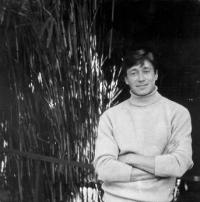
Georgy Ivanovich Rerberg was a Soviet cinematographer.

A wasp is any insect of the narrow-waisted suborder Apocrita of the order Hymenoptera which is neither a bee nor an ant; this excludes the broad-waisted sawflies (Symphyta), which look somewhat like wasps, but are in a separate suborder. The wasps do not constitute a clade, a complete natural group with a single ancestor, as bees and ants are deeply nested within the wasps, having evolved from wasp ancestors. Wasps that are members of the clade Aculeata can sting their prey.
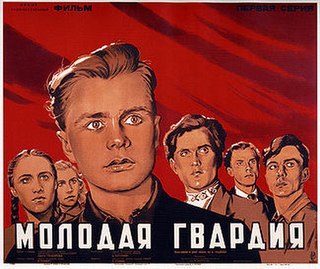
The Young Guard is a two-part 1948 Soviet film directed by Sergei Gerasimov and based on the novel of the same title by Alexander Fadeyev. In 1949 a Stalin Prize for this film was awarded to Gerasimov, cinematographer Vladimir Rapoport, and the group of leading actors.
Georgian Film Studio is one of world's oldest film studios that has produced 800 features, made-for-TV and short films, 600 documentaries, and 300 animation movies. During Soviet times, the studio was one of the most active places for film production. Having grown organically from the merger of several film production companies that operated in the beginning of the twentieth century in Tbilisi, the studio had been renamed several times before becoming Georgian Film in 1953. Sitting on 9.75 hectares of prime land in Tbilisi, Georgian Film Studios offers several sound stages, recording and editing facilities, various production services, modern equipment and professional crews. Georgian Film was founded in 1921.

The Youth of Maxim is a 1935 Soviet historical drama film directed by Grigori Kozintsev and Leonid Trauberg, the first part of trilogy about the life of a young factory worker named Maxim.
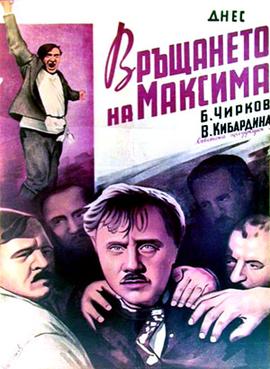
The Return of Maxim is a 1937 Soviet drama film directed by Grigori Kozintsev and Leonid Trauberg, the second part of trilogy about the life of a young factory worker, Maxim.

The Vyborg Side is a 1939 Soviet drama film directed by Grigori Kozintsev and Leonid Trauberg, the final part of trilogy about the life of a young factory worker, Maxim. The film was also released in the United States under the title New Horizons.
Vera Pavlovna Stroyeva was a Soviet film director and screenwriter. Between 1926 and 1983, she directed fifteen films and wrote ten screenplays. Her film adaptation of Modest Mussorgsky's opera Boris Godunov was nominated for a Golden Lion at the 16th Venice International Film Festival and screened out of competition at the 1987 Cannes Film Festival. Many of her films are musicals or adaptations of operas and feature heavy influence from socialist realism.

Polistes chinensis is a polistine vespid wasp in the cosmopolitan genus Polistes, and is commonly known as the Asian, Chinese or Japanese paper wasp. It is found in East Asia, in particular China and Japan. The subspecies P. chinensis antennalis is an invasive species in New Zealand, having arrived in 1979.
Giorgi Shengelaia was a Georgian and Soviet film director. He directed 14 films since 1961. His film Pirosmani won the Grand Prize at the Chicago International Film Festival in 1974 and went on to international critical acclaim. His 1985 film The Journey of a Young Composer was entered into the 36th Berlin International Film Festival where he won the Silver Bear for Best Director.
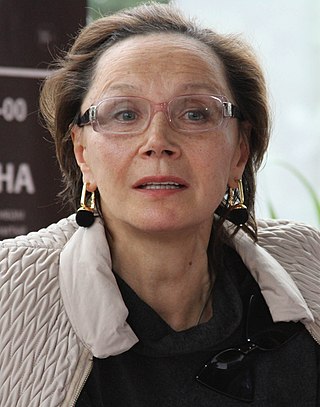
Irina Petrovna Kupchenko is a Soviet and Russian stage and film actress. She rose to prominence after acting in Andrei Konchalovsky's 1969 movie adaptation of A Nest of Gentry. She has performed in more than forty films since 1969.
The Lights of Baku is a 1950 Soviet drama film directed by Iosif Kheifits, Rza Tahmasib and Aleksandr Zarkhi. The film portrays workers in the oil fields of Azerbaijan during the Second World War, when they were of great strategic importance. Scenes featuring Mikheil Gelovani as Joseph Stalin were later cut after the dictator's death when his cult of personality had come under attack from the new Soviet leadership.
Ilan-dili is a 1926 Soviet silent action adventure film directed by Ivane Perestiani. It is the sequel to the film The Savur Grave.
The Crime of Shirvanskaya is a 1926 Soviet silent action adventure film directed by Ivane Perestiani.
The Punishment of Shirvanskaya (Georgian:Sasdjeli) is a 1926 Soviet silent action adventure film directed by Ivane Perestiani. It is a sequel to The Crime of Shirvanskaya.
Lyubov Yarovaya is a 1953 Soviet drama film directed by Yan Frid as film adaptation of the original stage production at Leningrad Bolshoi Drama Theater premiered in 1951. Both the stage production and its film adaptation were based on a 1926 play of the same name by Konstantin Trenyov, which was later adapted a second time as a 1970 film made at Lenfilm studios and starring a new generation of actors. The 1953 film was the most popular film released in the Soviet Union that year, with attendance of more than 46 million.
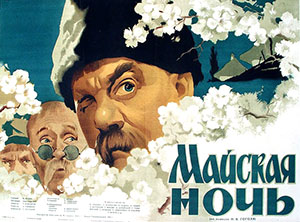
May Nights is a 1952 Soviet 3D fantasy comedy film released by Moscow Gorky Film Studios, directed by Aleksandr Rou and starring Nikolai Dosenko, Tatyana Konyukhova and Aleksandr Khvylya. It is based on Nikolai Gogol's May Night, or the Drowned Maiden and the subsequent opera version by Nikolai Rimsky-Korsakov. It was directed by Alexander Rowe. The film is notable for being the first full-length autostereoscopic film in colour.
References
- ↑ Rollberg p.527